Drug Addiction, Overdose, and Common Good: A Global Report
VerifiedAdded on 2022/12/23
|7
|1904
|25
Report
AI Summary
This report addresses the global health crisis of drug addiction and overdose, emphasizing the failure to realize shared responsibility for the common good. It critiques the issue, referencing existing literature on the impact of economic recessions, social factors, and the role of polydrug use. The report highlights the importance of treatment programs, community engagement, and advocacy to reduce risk factors and improve outcomes. The report also explores the effectiveness of models like Alcoholic Anonymous (AA) in addressing addiction. The author proposes ways to address this challenge within the nursing profession, locally, and globally, emphasizing the application of principles like human dignity, advocacy, and community engagement to improve public health and well-being.
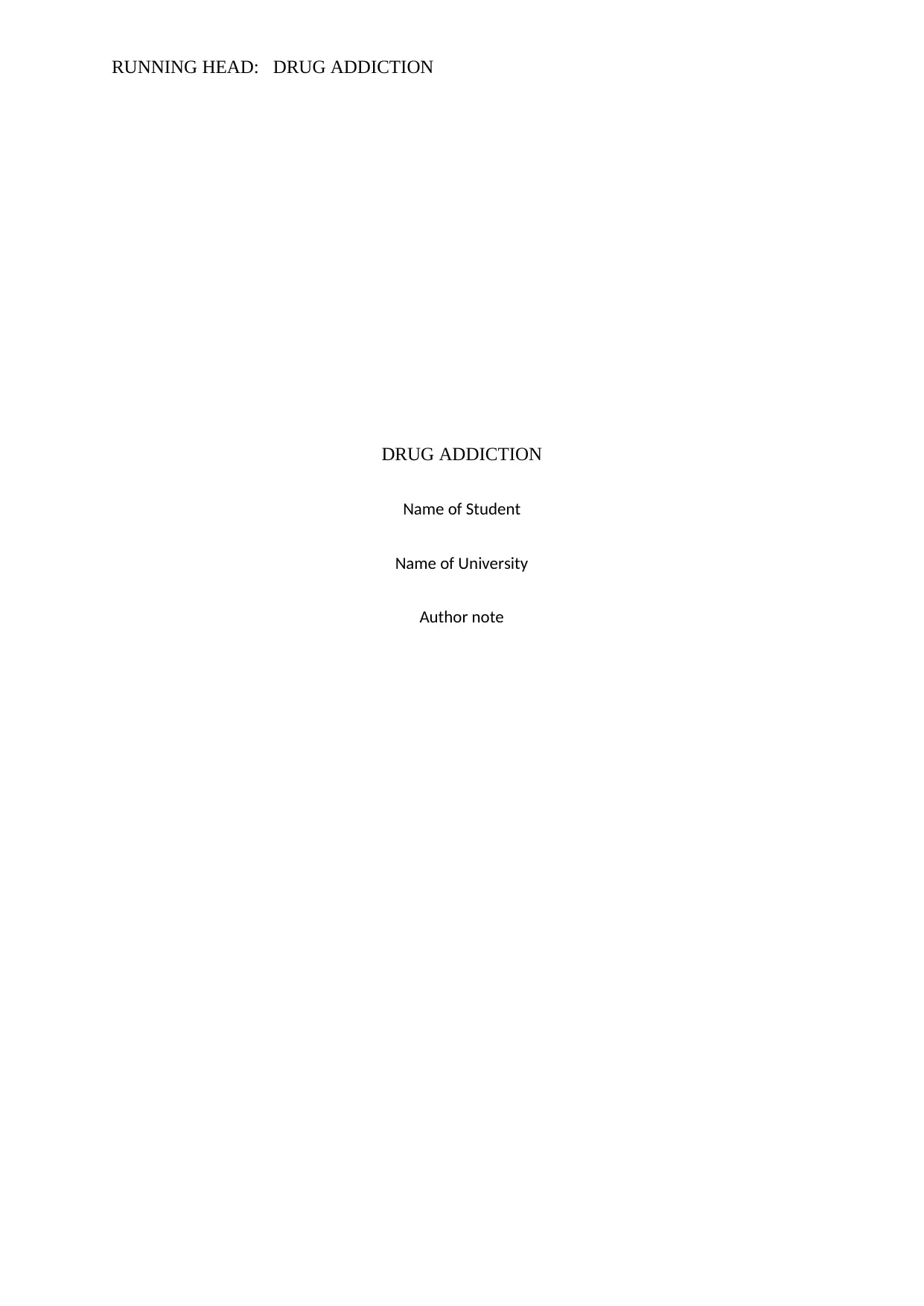
RUNNING HEAD: DRUG ADDICTION
DRUG ADDICTION
Name of Student
Name of University
Author note
DRUG ADDICTION
Name of Student
Name of University
Author note
Secure Best Marks with AI Grader
Need help grading? Try our AI Grader for instant feedback on your assignments.
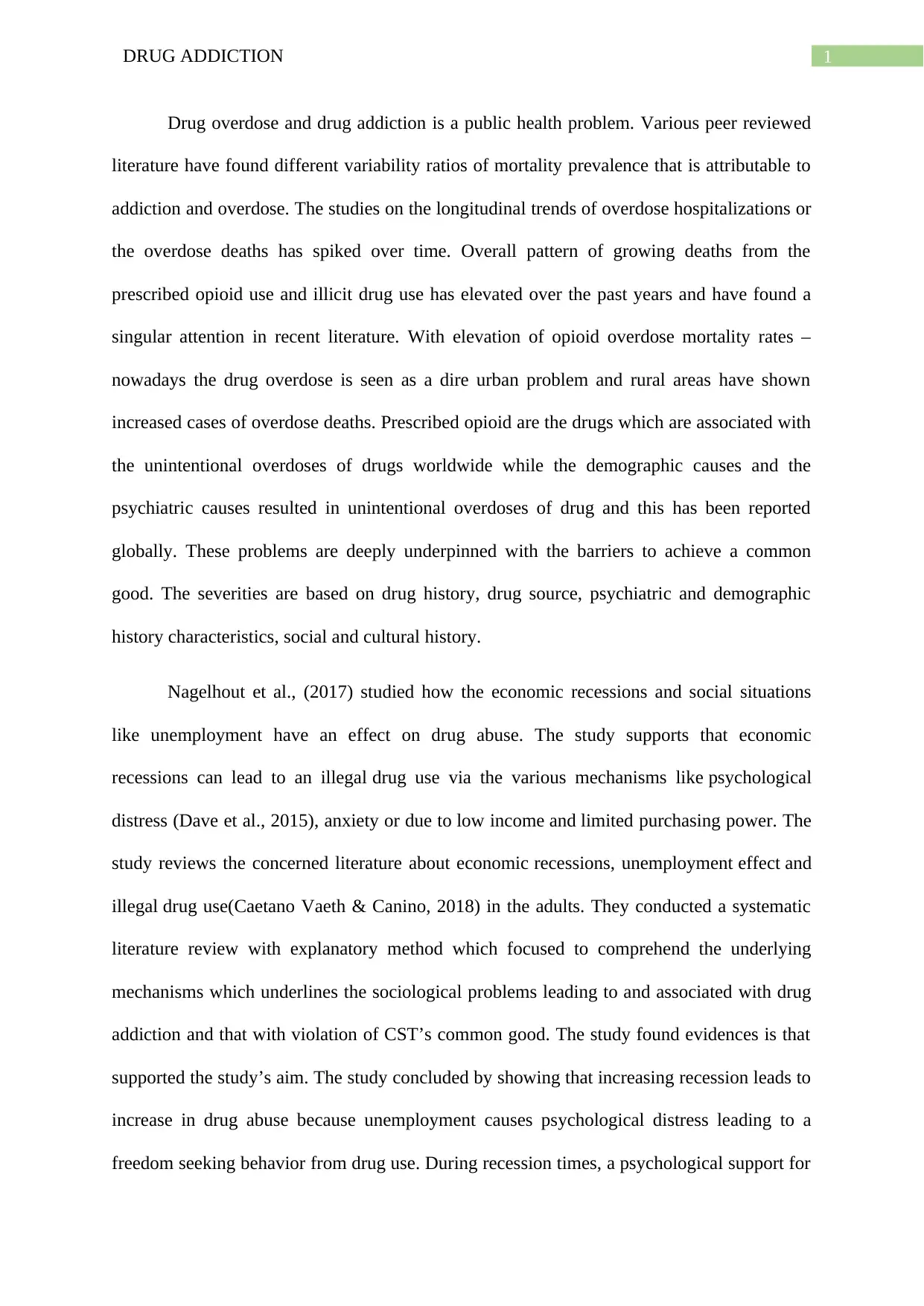
1DRUG ADDICTION
Drug overdose and drug addiction is a public health problem. Various peer reviewed
literature have found different variability ratios of mortality prevalence that is attributable to
addiction and overdose. The studies on the longitudinal trends of overdose hospitalizations or
the overdose deaths has spiked over time. Overall pattern of growing deaths from the
prescribed opioid use and illicit drug use has elevated over the past years and have found a
singular attention in recent literature. With elevation of opioid overdose mortality rates –
nowadays the drug overdose is seen as a dire urban problem and rural areas have shown
increased cases of overdose deaths. Prescribed opioid are the drugs which are associated with
the unintentional overdoses of drugs worldwide while the demographic causes and the
psychiatric causes resulted in unintentional overdoses of drug and this has been reported
globally. These problems are deeply underpinned with the barriers to achieve a common
good. The severities are based on drug history, drug source, psychiatric and demographic
history characteristics, social and cultural history.
Nagelhout et al., (2017) studied how the economic recessions and social situations
like unemployment have an effect on drug abuse. The study supports that economic
recessions can lead to an illegal drug use via the various mechanisms like psychological
distress (Dave et al., 2015), anxiety or due to low income and limited purchasing power. The
study reviews the concerned literature about economic recessions, unemployment effect and
illegal drug use(Caetano Vaeth & Canino, 2018) in the adults. They conducted a systematic
literature review with explanatory method which focused to comprehend the underlying
mechanisms which underlines the sociological problems leading to and associated with drug
addiction and that with violation of CST’s common good. The study found evidences is that
supported the study’s aim. The study concluded by showing that increasing recession leads to
increase in drug abuse because unemployment causes psychological distress leading to a
freedom seeking behavior from drug use. During recession times, a psychological support for
Drug overdose and drug addiction is a public health problem. Various peer reviewed
literature have found different variability ratios of mortality prevalence that is attributable to
addiction and overdose. The studies on the longitudinal trends of overdose hospitalizations or
the overdose deaths has spiked over time. Overall pattern of growing deaths from the
prescribed opioid use and illicit drug use has elevated over the past years and have found a
singular attention in recent literature. With elevation of opioid overdose mortality rates –
nowadays the drug overdose is seen as a dire urban problem and rural areas have shown
increased cases of overdose deaths. Prescribed opioid are the drugs which are associated with
the unintentional overdoses of drugs worldwide while the demographic causes and the
psychiatric causes resulted in unintentional overdoses of drug and this has been reported
globally. These problems are deeply underpinned with the barriers to achieve a common
good. The severities are based on drug history, drug source, psychiatric and demographic
history characteristics, social and cultural history.
Nagelhout et al., (2017) studied how the economic recessions and social situations
like unemployment have an effect on drug abuse. The study supports that economic
recessions can lead to an illegal drug use via the various mechanisms like psychological
distress (Dave et al., 2015), anxiety or due to low income and limited purchasing power. The
study reviews the concerned literature about economic recessions, unemployment effect and
illegal drug use(Caetano Vaeth & Canino, 2018) in the adults. They conducted a systematic
literature review with explanatory method which focused to comprehend the underlying
mechanisms which underlines the sociological problems leading to and associated with drug
addiction and that with violation of CST’s common good. The study found evidences is that
supported the study’s aim. The study concluded by showing that increasing recession leads to
increase in drug abuse because unemployment causes psychological distress leading to a
freedom seeking behavior from drug use. During recession times, a psychological support for
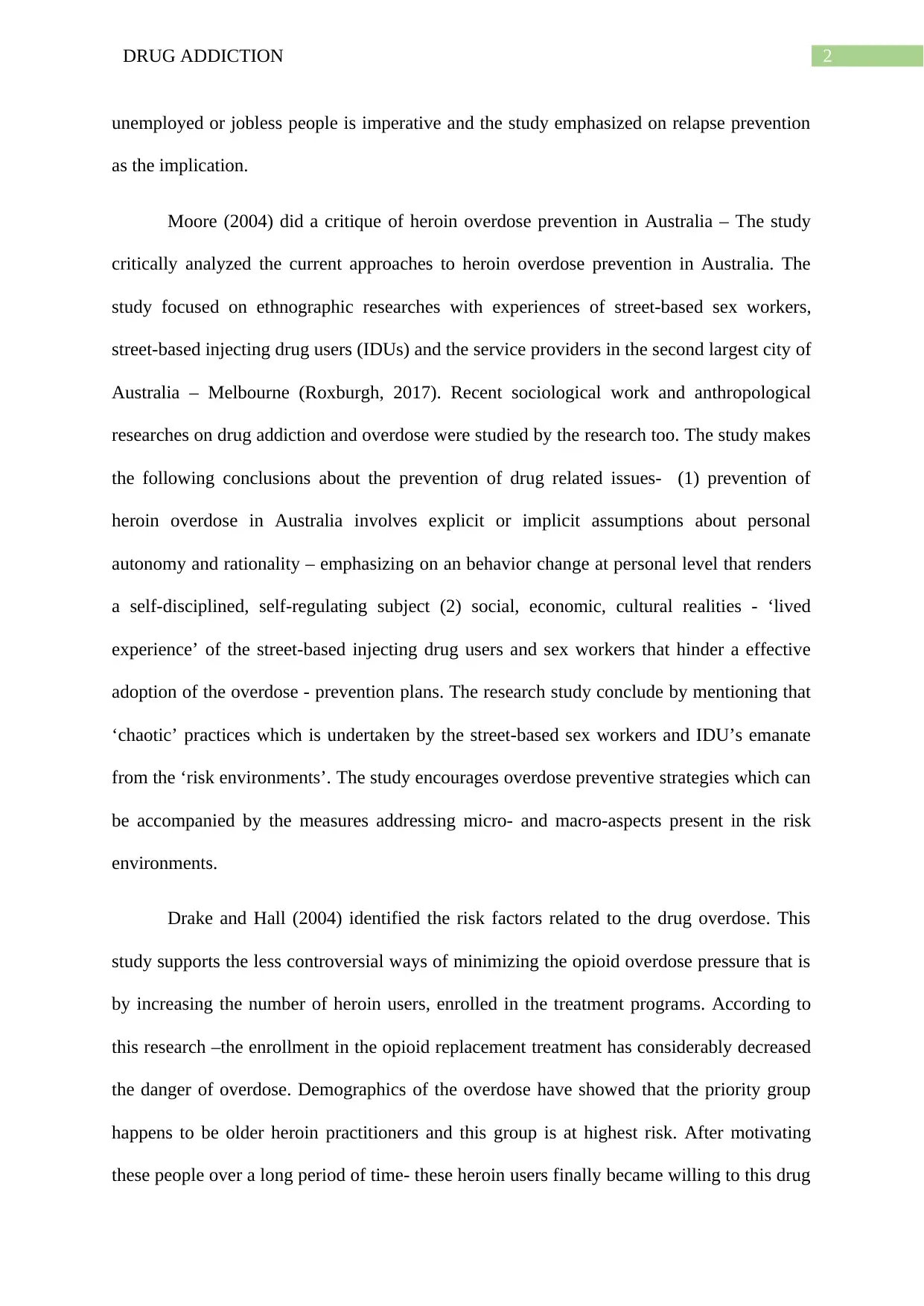
2DRUG ADDICTION
unemployed or jobless people is imperative and the study emphasized on relapse prevention
as the implication.
Moore (2004) did a critique of heroin overdose prevention in Australia – The study
critically analyzed the current approaches to heroin overdose prevention in Australia. The
study focused on ethnographic researches with experiences of street-based sex workers,
street-based injecting drug users (IDUs) and the service providers in the second largest city of
Australia – Melbourne (Roxburgh, 2017). Recent sociological work and anthropological
researches on drug addiction and overdose were studied by the research too. The study makes
the following conclusions about the prevention of drug related issues- (1) prevention of
heroin overdose in Australia involves explicit or implicit assumptions about personal
autonomy and rationality – emphasizing on an behavior change at personal level that renders
a self-disciplined, self-regulating subject (2) social, economic, cultural realities - ‘lived
experience’ of the street-based injecting drug users and sex workers that hinder a effective
adoption of the overdose - prevention plans. The research study conclude by mentioning that
‘chaotic’ practices which is undertaken by the street-based sex workers and IDU’s emanate
from the ‘risk environments’. The study encourages overdose preventive strategies which can
be accompanied by the measures addressing micro- and macro-aspects present in the risk
environments.
Drake and Hall (2004) identified the risk factors related to the drug overdose. This
study supports the less controversial ways of minimizing the opioid overdose pressure that is
by increasing the number of heroin users, enrolled in the treatment programs. According to
this research –the enrollment in the opioid replacement treatment has considerably decreased
the danger of overdose. Demographics of the overdose have showed that the priority group
happens to be older heroin practitioners and this group is at highest risk. After motivating
these people over a long period of time- these heroin users finally became willing to this drug
unemployed or jobless people is imperative and the study emphasized on relapse prevention
as the implication.
Moore (2004) did a critique of heroin overdose prevention in Australia – The study
critically analyzed the current approaches to heroin overdose prevention in Australia. The
study focused on ethnographic researches with experiences of street-based sex workers,
street-based injecting drug users (IDUs) and the service providers in the second largest city of
Australia – Melbourne (Roxburgh, 2017). Recent sociological work and anthropological
researches on drug addiction and overdose were studied by the research too. The study makes
the following conclusions about the prevention of drug related issues- (1) prevention of
heroin overdose in Australia involves explicit or implicit assumptions about personal
autonomy and rationality – emphasizing on an behavior change at personal level that renders
a self-disciplined, self-regulating subject (2) social, economic, cultural realities - ‘lived
experience’ of the street-based injecting drug users and sex workers that hinder a effective
adoption of the overdose - prevention plans. The research study conclude by mentioning that
‘chaotic’ practices which is undertaken by the street-based sex workers and IDU’s emanate
from the ‘risk environments’. The study encourages overdose preventive strategies which can
be accompanied by the measures addressing micro- and macro-aspects present in the risk
environments.
Drake and Hall (2004) identified the risk factors related to the drug overdose. This
study supports the less controversial ways of minimizing the opioid overdose pressure that is
by increasing the number of heroin users, enrolled in the treatment programs. According to
this research –the enrollment in the opioid replacement treatment has considerably decreased
the danger of overdose. Demographics of the overdose have showed that the priority group
happens to be older heroin practitioners and this group is at highest risk. After motivating
these people over a long period of time- these heroin users finally became willing to this drug
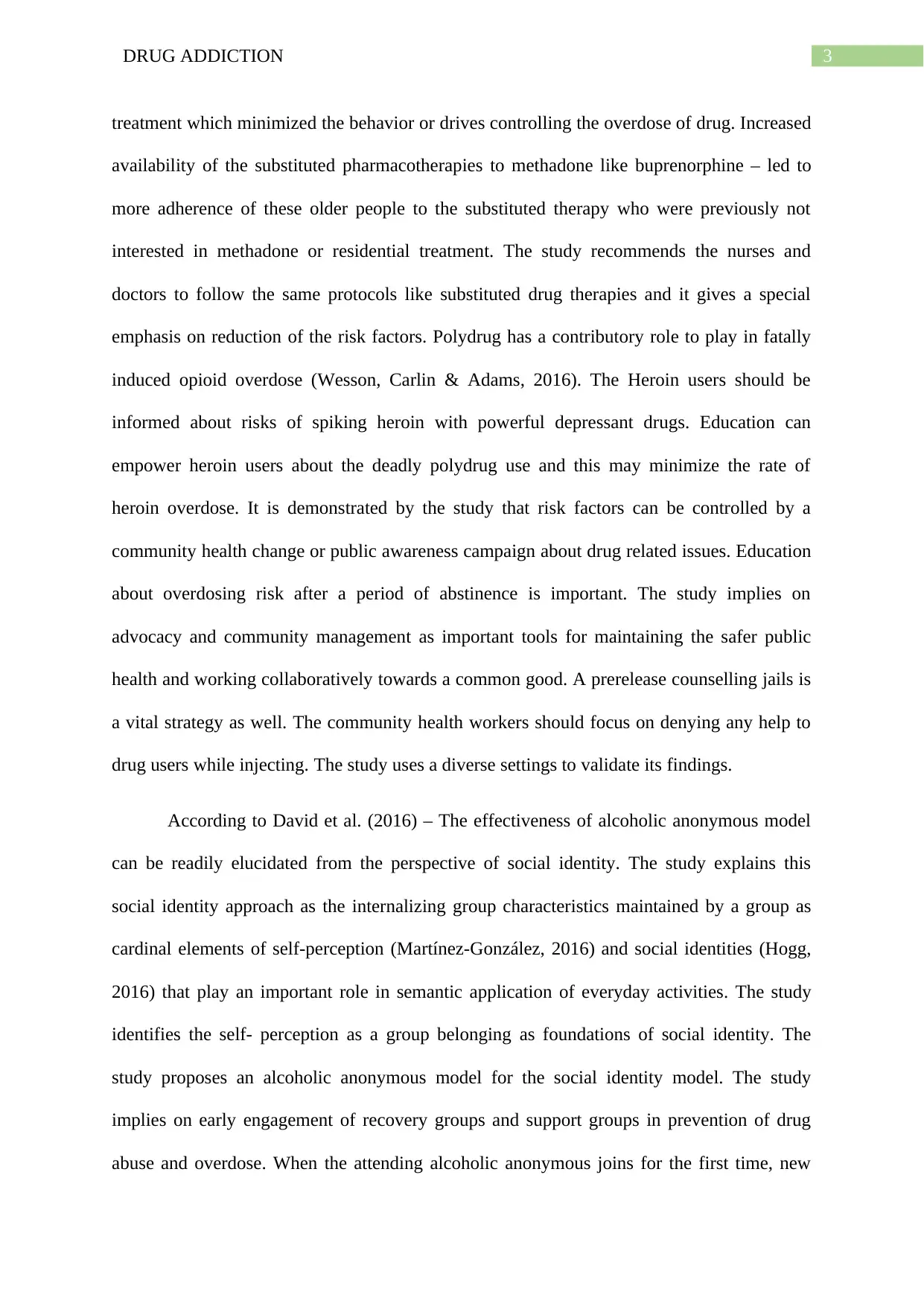
3DRUG ADDICTION
treatment which minimized the behavior or drives controlling the overdose of drug. Increased
availability of the substituted pharmacotherapies to methadone like buprenorphine – led to
more adherence of these older people to the substituted therapy who were previously not
interested in methadone or residential treatment. The study recommends the nurses and
doctors to follow the same protocols like substituted drug therapies and it gives a special
emphasis on reduction of the risk factors. Polydrug has a contributory role to play in fatally
induced opioid overdose (Wesson, Carlin & Adams, 2016). The Heroin users should be
informed about risks of spiking heroin with powerful depressant drugs. Education can
empower heroin users about the deadly polydrug use and this may minimize the rate of
heroin overdose. It is demonstrated by the study that risk factors can be controlled by a
community health change or public awareness campaign about drug related issues. Education
about overdosing risk after a period of abstinence is important. The study implies on
advocacy and community management as important tools for maintaining the safer public
health and working collaboratively towards a common good. A prerelease counselling jails is
a vital strategy as well. The community health workers should focus on denying any help to
drug users while injecting. The study uses a diverse settings to validate its findings.
According to David et al. (2016) – The effectiveness of alcoholic anonymous model
can be readily elucidated from the perspective of social identity. The study explains this
social identity approach as the internalizing group characteristics maintained by a group as
cardinal elements of self-perception (Martínez-González, 2016) and social identities (Hogg,
2016) that play an important role in semantic application of everyday activities. The study
identifies the self- perception as a group belonging as foundations of social identity. The
study proposes an alcoholic anonymous model for the social identity model. The study
implies on early engagement of recovery groups and support groups in prevention of drug
abuse and overdose. When the attending alcoholic anonymous joins for the first time, new
treatment which minimized the behavior or drives controlling the overdose of drug. Increased
availability of the substituted pharmacotherapies to methadone like buprenorphine – led to
more adherence of these older people to the substituted therapy who were previously not
interested in methadone or residential treatment. The study recommends the nurses and
doctors to follow the same protocols like substituted drug therapies and it gives a special
emphasis on reduction of the risk factors. Polydrug has a contributory role to play in fatally
induced opioid overdose (Wesson, Carlin & Adams, 2016). The Heroin users should be
informed about risks of spiking heroin with powerful depressant drugs. Education can
empower heroin users about the deadly polydrug use and this may minimize the rate of
heroin overdose. It is demonstrated by the study that risk factors can be controlled by a
community health change or public awareness campaign about drug related issues. Education
about overdosing risk after a period of abstinence is important. The study implies on
advocacy and community management as important tools for maintaining the safer public
health and working collaboratively towards a common good. A prerelease counselling jails is
a vital strategy as well. The community health workers should focus on denying any help to
drug users while injecting. The study uses a diverse settings to validate its findings.
According to David et al. (2016) – The effectiveness of alcoholic anonymous model
can be readily elucidated from the perspective of social identity. The study explains this
social identity approach as the internalizing group characteristics maintained by a group as
cardinal elements of self-perception (Martínez-González, 2016) and social identities (Hogg,
2016) that play an important role in semantic application of everyday activities. The study
identifies the self- perception as a group belonging as foundations of social identity. The
study proposes an alcoholic anonymous model for the social identity model. The study
implies on early engagement of recovery groups and support groups in prevention of drug
abuse and overdose. When the attending alcoholic anonymous joins for the first time, new
Secure Best Marks with AI Grader
Need help grading? Try our AI Grader for instant feedback on your assignments.
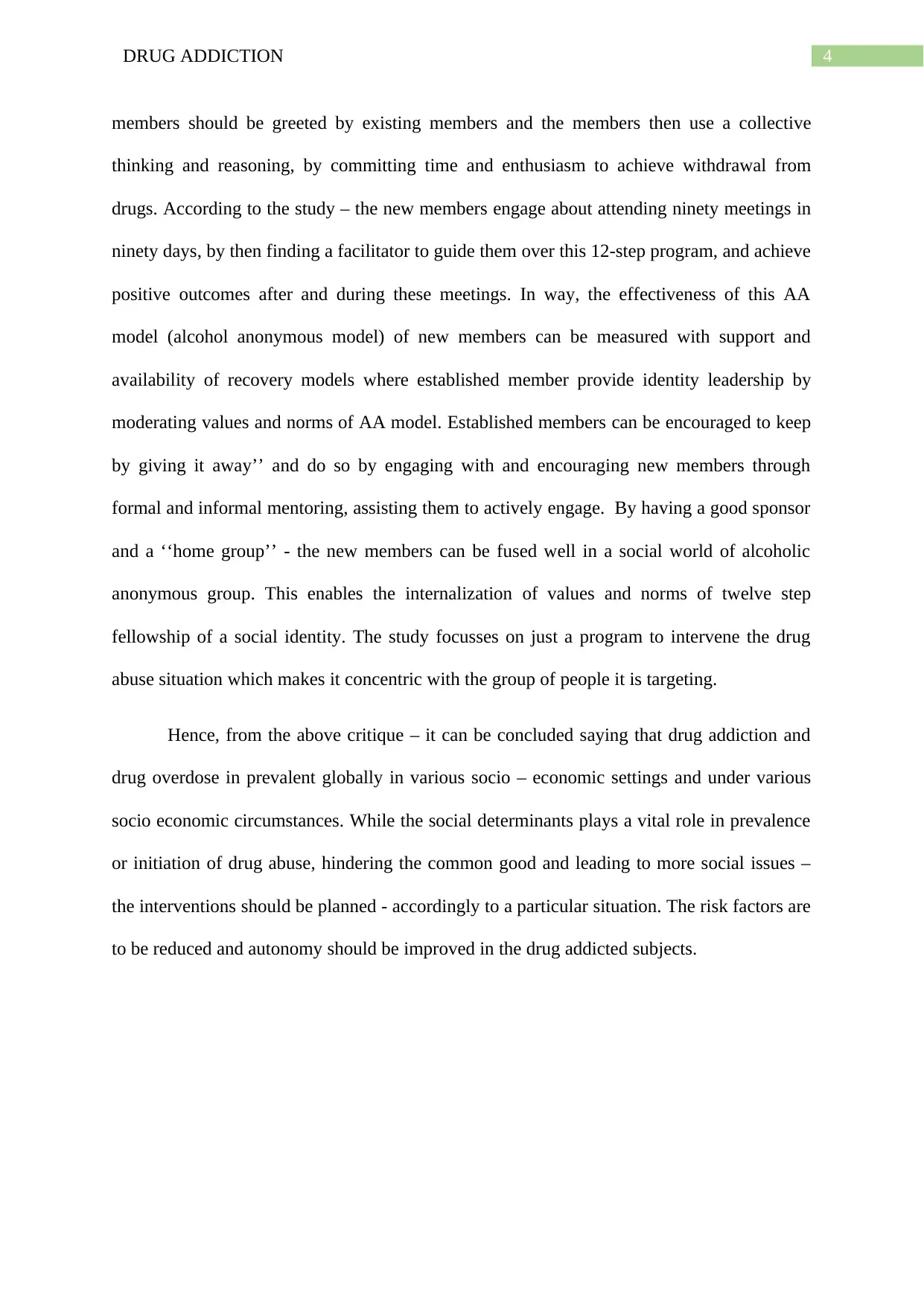
4DRUG ADDICTION
members should be greeted by existing members and the members then use a collective
thinking and reasoning, by committing time and enthusiasm to achieve withdrawal from
drugs. According to the study – the new members engage about attending ninety meetings in
ninety days, by then finding a facilitator to guide them over this 12-step program, and achieve
positive outcomes after and during these meetings. In way, the effectiveness of this AA
model (alcohol anonymous model) of new members can be measured with support and
availability of recovery models where established member provide identity leadership by
moderating values and norms of AA model. Established members can be encouraged to keep
by giving it away’’ and do so by engaging with and encouraging new members through
formal and informal mentoring, assisting them to actively engage. By having a good sponsor
and a ‘‘home group’’ - the new members can be fused well in a social world of alcoholic
anonymous group. This enables the internalization of values and norms of twelve step
fellowship of a social identity. The study focusses on just a program to intervene the drug
abuse situation which makes it concentric with the group of people it is targeting.
Hence, from the above critique – it can be concluded saying that drug addiction and
drug overdose in prevalent globally in various socio – economic settings and under various
socio economic circumstances. While the social determinants plays a vital role in prevalence
or initiation of drug abuse, hindering the common good and leading to more social issues –
the interventions should be planned - accordingly to a particular situation. The risk factors are
to be reduced and autonomy should be improved in the drug addicted subjects.
members should be greeted by existing members and the members then use a collective
thinking and reasoning, by committing time and enthusiasm to achieve withdrawal from
drugs. According to the study – the new members engage about attending ninety meetings in
ninety days, by then finding a facilitator to guide them over this 12-step program, and achieve
positive outcomes after and during these meetings. In way, the effectiveness of this AA
model (alcohol anonymous model) of new members can be measured with support and
availability of recovery models where established member provide identity leadership by
moderating values and norms of AA model. Established members can be encouraged to keep
by giving it away’’ and do so by engaging with and encouraging new members through
formal and informal mentoring, assisting them to actively engage. By having a good sponsor
and a ‘‘home group’’ - the new members can be fused well in a social world of alcoholic
anonymous group. This enables the internalization of values and norms of twelve step
fellowship of a social identity. The study focusses on just a program to intervene the drug
abuse situation which makes it concentric with the group of people it is targeting.
Hence, from the above critique – it can be concluded saying that drug addiction and
drug overdose in prevalent globally in various socio – economic settings and under various
socio economic circumstances. While the social determinants plays a vital role in prevalence
or initiation of drug abuse, hindering the common good and leading to more social issues –
the interventions should be planned - accordingly to a particular situation. The risk factors are
to be reduced and autonomy should be improved in the drug addicted subjects.
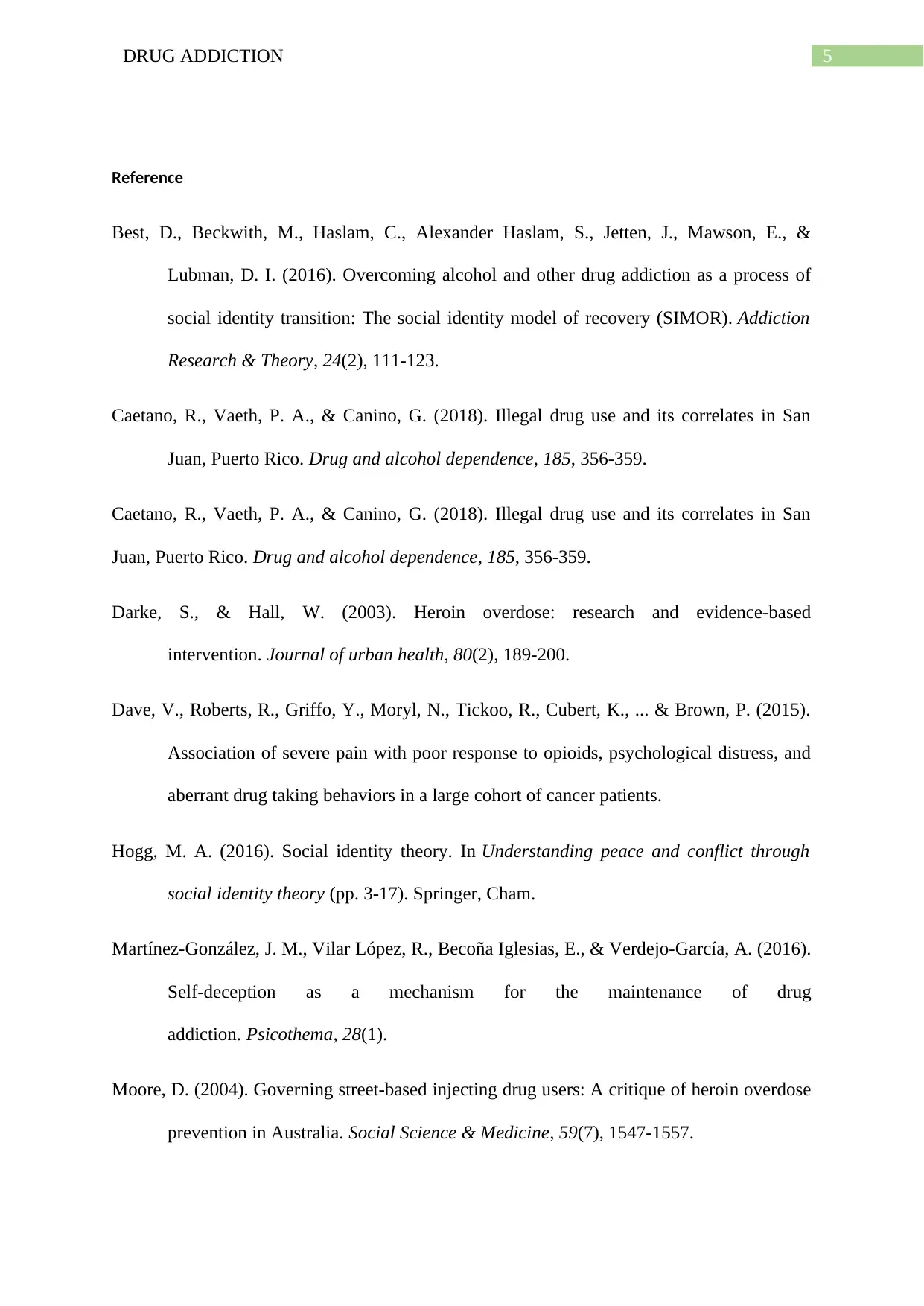
5DRUG ADDICTION
Reference
Best, D., Beckwith, M., Haslam, C., Alexander Haslam, S., Jetten, J., Mawson, E., &
Lubman, D. I. (2016). Overcoming alcohol and other drug addiction as a process of
social identity transition: The social identity model of recovery (SIMOR). Addiction
Research & Theory, 24(2), 111-123.
Caetano, R., Vaeth, P. A., & Canino, G. (2018). Illegal drug use and its correlates in San
Juan, Puerto Rico. Drug and alcohol dependence, 185, 356-359.
Caetano, R., Vaeth, P. A., & Canino, G. (2018). Illegal drug use and its correlates in San
Juan, Puerto Rico. Drug and alcohol dependence, 185, 356-359.
Darke, S., & Hall, W. (2003). Heroin overdose: research and evidence-based
intervention. Journal of urban health, 80(2), 189-200.
Dave, V., Roberts, R., Griffo, Y., Moryl, N., Tickoo, R., Cubert, K., ... & Brown, P. (2015).
Association of severe pain with poor response to opioids, psychological distress, and
aberrant drug taking behaviors in a large cohort of cancer patients.
Hogg, M. A. (2016). Social identity theory. In Understanding peace and conflict through
social identity theory (pp. 3-17). Springer, Cham.
Martínez-González, J. M., Vilar López, R., Becoña Iglesias, E., & Verdejo-García, A. (2016).
Self-deception as a mechanism for the maintenance of drug
addiction. Psicothema, 28(1).
Moore, D. (2004). Governing street-based injecting drug users: A critique of heroin overdose
prevention in Australia. Social Science & Medicine, 59(7), 1547-1557.
Reference
Best, D., Beckwith, M., Haslam, C., Alexander Haslam, S., Jetten, J., Mawson, E., &
Lubman, D. I. (2016). Overcoming alcohol and other drug addiction as a process of
social identity transition: The social identity model of recovery (SIMOR). Addiction
Research & Theory, 24(2), 111-123.
Caetano, R., Vaeth, P. A., & Canino, G. (2018). Illegal drug use and its correlates in San
Juan, Puerto Rico. Drug and alcohol dependence, 185, 356-359.
Caetano, R., Vaeth, P. A., & Canino, G. (2018). Illegal drug use and its correlates in San
Juan, Puerto Rico. Drug and alcohol dependence, 185, 356-359.
Darke, S., & Hall, W. (2003). Heroin overdose: research and evidence-based
intervention. Journal of urban health, 80(2), 189-200.
Dave, V., Roberts, R., Griffo, Y., Moryl, N., Tickoo, R., Cubert, K., ... & Brown, P. (2015).
Association of severe pain with poor response to opioids, psychological distress, and
aberrant drug taking behaviors in a large cohort of cancer patients.
Hogg, M. A. (2016). Social identity theory. In Understanding peace and conflict through
social identity theory (pp. 3-17). Springer, Cham.
Martínez-González, J. M., Vilar López, R., Becoña Iglesias, E., & Verdejo-García, A. (2016).
Self-deception as a mechanism for the maintenance of drug
addiction. Psicothema, 28(1).
Moore, D. (2004). Governing street-based injecting drug users: A critique of heroin overdose
prevention in Australia. Social Science & Medicine, 59(7), 1547-1557.
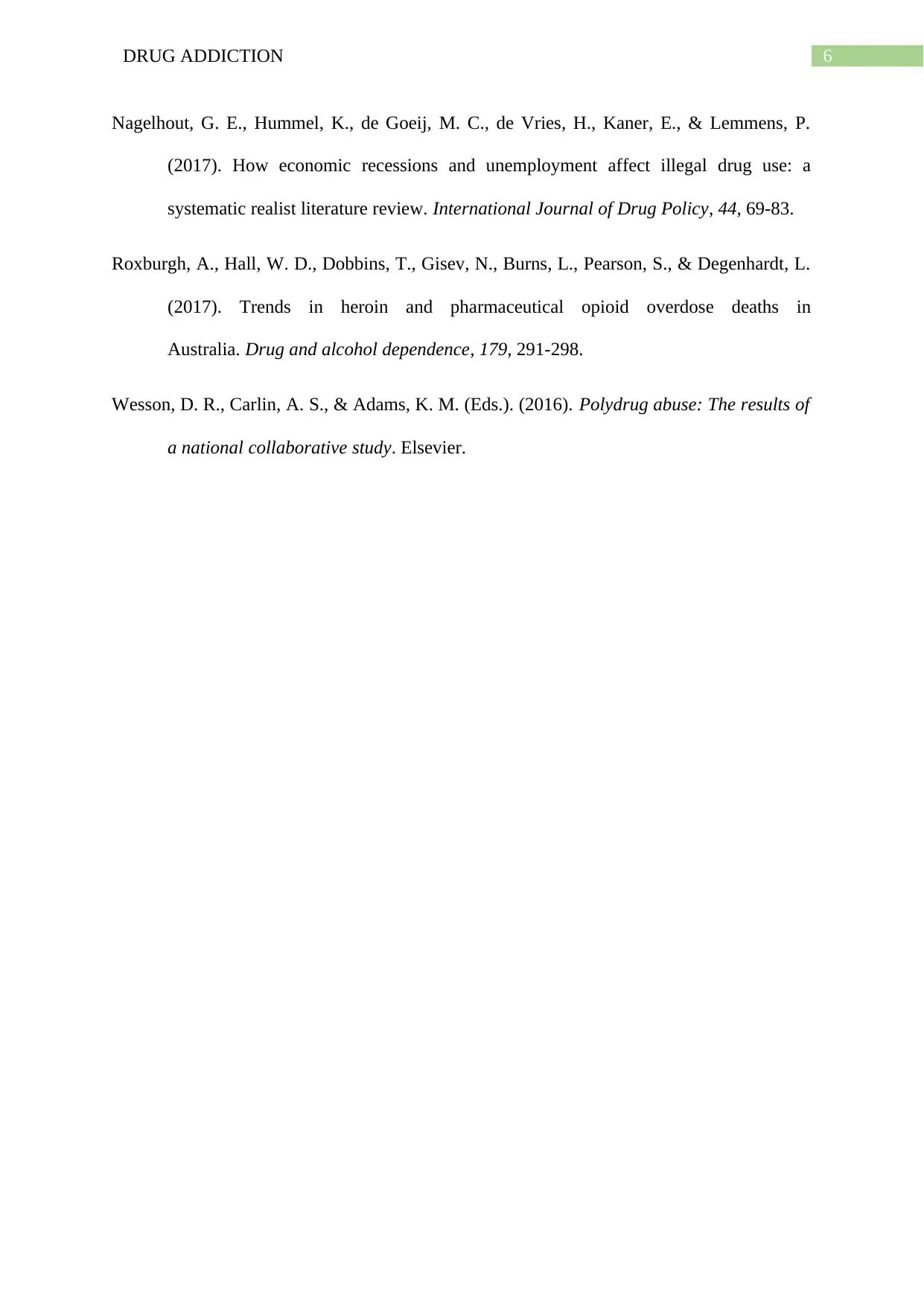
6DRUG ADDICTION
Nagelhout, G. E., Hummel, K., de Goeij, M. C., de Vries, H., Kaner, E., & Lemmens, P.
(2017). How economic recessions and unemployment affect illegal drug use: a
systematic realist literature review. International Journal of Drug Policy, 44, 69-83.
Roxburgh, A., Hall, W. D., Dobbins, T., Gisev, N., Burns, L., Pearson, S., & Degenhardt, L.
(2017). Trends in heroin and pharmaceutical opioid overdose deaths in
Australia. Drug and alcohol dependence, 179, 291-298.
Wesson, D. R., Carlin, A. S., & Adams, K. M. (Eds.). (2016). Polydrug abuse: The results of
a national collaborative study. Elsevier.
Nagelhout, G. E., Hummel, K., de Goeij, M. C., de Vries, H., Kaner, E., & Lemmens, P.
(2017). How economic recessions and unemployment affect illegal drug use: a
systematic realist literature review. International Journal of Drug Policy, 44, 69-83.
Roxburgh, A., Hall, W. D., Dobbins, T., Gisev, N., Burns, L., Pearson, S., & Degenhardt, L.
(2017). Trends in heroin and pharmaceutical opioid overdose deaths in
Australia. Drug and alcohol dependence, 179, 291-298.
Wesson, D. R., Carlin, A. S., & Adams, K. M. (Eds.). (2016). Polydrug abuse: The results of
a national collaborative study. Elsevier.
1 out of 7
Your All-in-One AI-Powered Toolkit for Academic Success.
+13062052269
info@desklib.com
Available 24*7 on WhatsApp / Email
![[object Object]](/_next/static/media/star-bottom.7253800d.svg)
Unlock your academic potential
© 2024 | Zucol Services PVT LTD | All rights reserved.
